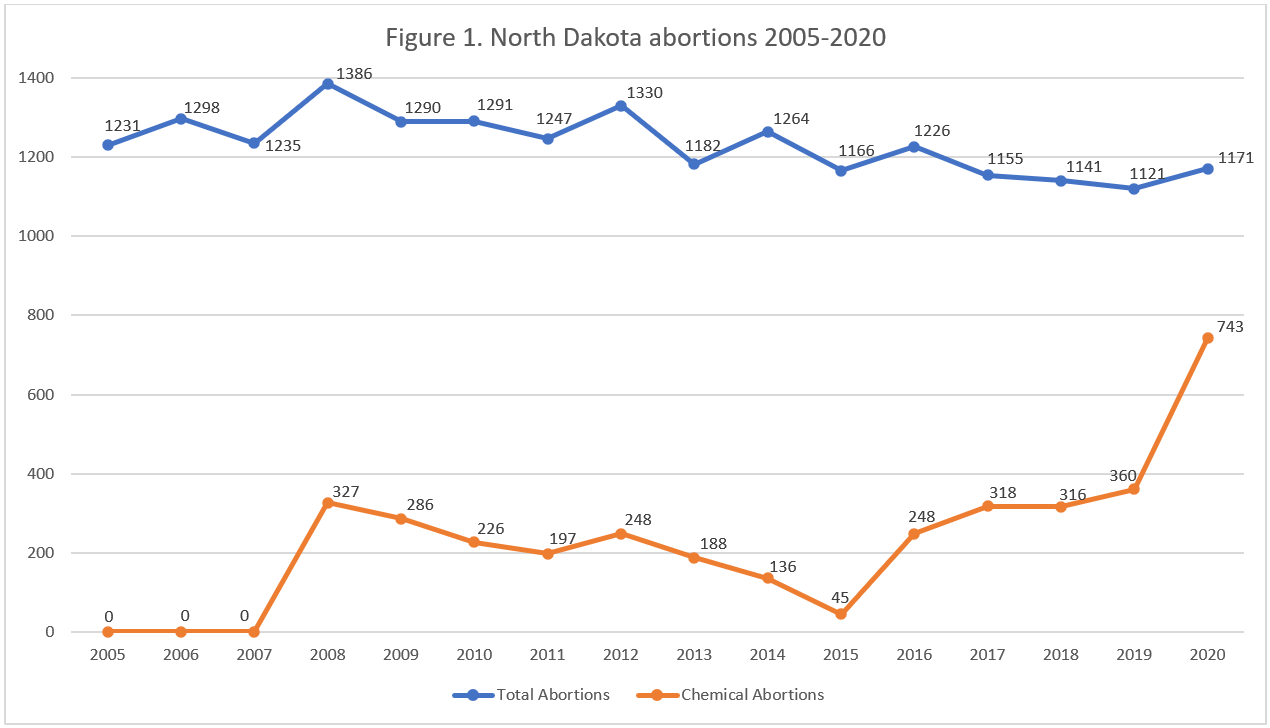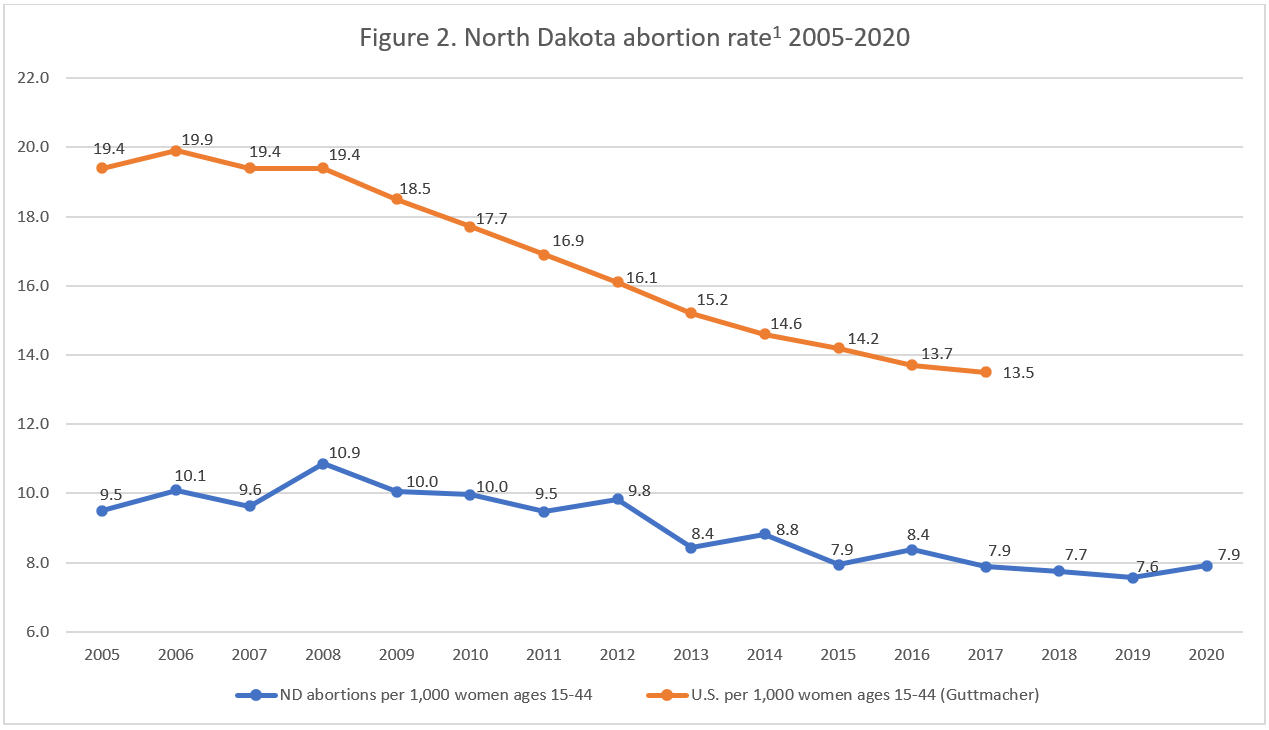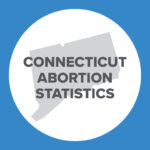Abortion Reporting: North Dakota (2020)
North Dakota was the third state to release 2020 abortion statistics, publishing its 2020 abortion report in April 2021.
Changes in North Dakota Abortions, 2019-2020

The report does not include information on Planned Parenthood’s North Dakota abortion market share, but Planned Parenthood operates no centers in North Dakota.
Abortion Totals and Trends
In 2020, there were 1,171 abortions reported in North Dakota, up four percent from the previous year (Fig. 1). Chemical abortions reached a record high, surging by 106 percent from 360 in 2019 to 743 in 2020. The Charlotte Lozier Institute (CLI) estimates that North Dakota’s 2020 abortion rate was 7.9 abortions per 1,000 women ages 15 to 44, an increase of four percent from 2019 (Fig. 2). As of November 2021, 17 states have released 2020 abortion statistics with 12 reporting increases.
State Report Summary
The increase in North Dakota abortions between 2019 and 2020 was due to additional abortions on nonresident women; abortions performed on North Dakota residents were unchanged, with 833 abortions reported in 2019 and another 833 abortions reported in 2020. Abortions on women from other states made up 29 percent of the total in 2020, compared to 26 percent in 2019.
Ten percent of the abortions reported in North Dakota in 2020 were performed on girls ages 19 and younger. Thirty percent of the abortions were performed on women ages 20 to 24, and 29 percent were on women ages 25 to 29. However, because North Dakota has a large population of women in their early twenties, women ages 20 to 24 had a lower abortion rate (11.9 abortions per 1,000 women of childbearing age) than women ages 25 to 29 (12.1). Nineteen percent of the abortions were obtained by women in their early thirties, dropping to nine percent on women in their later thirties. Three percent of North Dakota abortions were performed on women ages 40 and older.
Sixty-two percent of the abortions were performed on white women, while 14 percent were on black women and 12 percent were on Native American women. Three percent of the abortions were performed on Asian women, and eight percent were on women of other or unreported races. CLI estimates that white women had the lowest abortion rate in 2020 (5.7 abortions per 1,000 women ages 15 to 44) while black women had the highest (24.4). However, as CLI has previously noted, North Dakota’s abortion reporting form does not include a separate checkbox for abortions performed on Asian women, meaning abortions among this group may be underreported.
Thirteen percent of the abortions were obtained by women who had not completed high school, while 36 percent were on women with a high school diploma. Nine percent of the abortions were performed on women who had attended some college, and 40 percent were on women with an associate’s degree or higher. Level of education was not reported for one percent of the abortions.
A majority of the abortions reported in North Dakota, 85 percent, were performed on unmarried women, compared to 15 percent on married women. Thirty-nine percent of the abortions were on women with no children, while 22 percent were on women with one child and 39 percent on women with two or more children. Nearly two-thirds of the abortions (66 percent) were performed on women with no previous abortions. Twenty-two percent were on women with one prior abortion, and 12 percent on women with more than one.
North Dakota’s single abortion center performs abortions up to 16 weeks of gestation, and in 2020 the vast majority of abortions occurred in the first or early second trimester. To lower the chances of incomplete abortions that would require follow-up visits, during the COVID-19 pandemic, the abortion center states it will not schedule an abortion until the pregnancy has reached six weeks. Eleven percent of North Dakota abortions occurred before six weeks of gestation in 2020, down from 17 percent in 2019. Twenty-eight percent of the abortions were reported at six weeks, and one-third occurred between seven and eight weeks of gestation. Fifteen percent were performed between nine and 10 weeks, and six percent occurred between 11 and 12 weeks. Seven percent of the abortions were reported between 13 and 15 weeks of gestation. Just one percent were performed at 16 weeks of gestation or later.
The month of April had the most abortions (120), while January had the fewest (81). North Dakota’s report does not include the types of procedures used to perform abortions in the state, but this information was provided to CLI upon request. In 2020, 63 percent of the abortions were chemical, up from 32 percent of the total in 2019. Thirty-seven percent were suction curettage procedures.
Chemical Abortion in North Dakota
North Dakota’s abortion center has announced that due to the COVID-19 pandemic, only chemical abortions will be performed before nine weeks of gestation. In 2020, the number of chemical abortions reported in North Dakota more than doubled from the prior year.
This was the largest percentage increase in North Dakota chemical abortions since 2016. In 2011, North Dakota enacted a law requiring doctors to follow the Food and Drug Administration’s official label when administering the abortion pill mifepristone. North Dakota’s abortion center sued, interpreting the law to prohibit the use of misoprostol, the second drug in the two-part chemical abortion cocktail, which would essentially limit all chemical abortions, and the law was temporarily blocked. However, the North Dakota Supreme Court upheld the law and ruled that abortion centers could use misoprostol as part of the approved FDA regimen, which required a higher dosage of the more expensive drug mifepristone and established more medical oversight of the chemical abortion process. The abortion center stated it was suspending chemical abortions, and only 45 were reported in 2015. In 2016, the FDA updated its chemical abortion safety guidelines to expand the gestational ages at which mifepristone could be used and require fewer visits to the abortion center, and North Dakota chemical abortions rose by over 450 percent.
State Ranking
In 2016, CLI published an analysis of abortion reporting across the 50 states, New York City, and the District of Columbia, and North Dakota’s reporting tied for 19th best. North Dakota could improve its reporting by including the types of procedures used to perform abortions in the state. Additionally, North Dakota could collect and report data on complications caused by abortion.


- Rates were calculated by CLI using the following formula: (total number of abortions performed in North Dakota ÷ number of resident women ages 15-44) x 1,000. Rates may differ slightly from previous CLI articles due to revised population estimates. Population estimates were obtained from the CDC WONDER database.
























